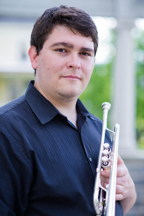Principal bassoon Aaron Apaza and principal trumpet Phillip Chase Hawkins have both been with the Knoxville Symphony Orchestra for only a couple of seasons, but their presence and effect on the ensemble have already been indisputably positive. On the Sunday afternoon Chamber Classics concert with Maestro Lucas Richman and the KSO Chamber Orchestra at the Bijou, both players had the opportunity to take the front of the stage in concerto solo roles in two works that are showcase vehicles for their respective instruments—works that also have the capability of delighting and entertaining audiences. And both players proved that they are splendid concerto soloists.
 Apaza’s work was the Bassoon Concerto in B-flat Major written by an 18-year old Wolfgang Amadeus Mozart—a work that, if nothing else, is a delightful technical test of the art of bassoon playing. Within it one finds two-octave leaps, maniacal finger work, and an abundance of trills. But one also finds gentle lyrical lines in the slow movement that draw out a player’s musical soul. Not only was Apaza technically superb, his performance achieved a vocal-like interpretation that carried it to a level that engaged the audience and entertained.
Apaza’s work was the Bassoon Concerto in B-flat Major written by an 18-year old Wolfgang Amadeus Mozart—a work that, if nothing else, is a delightful technical test of the art of bassoon playing. Within it one finds two-octave leaps, maniacal finger work, and an abundance of trills. But one also finds gentle lyrical lines in the slow movement that draw out a player’s musical soul. Not only was Apaza technically superb, his performance achieved a vocal-like interpretation that carried it to a level that engaged the audience and entertained.
Hawkins, too, put a definite stamp on his work, the Stamitz Trumpet Concerto in D. (for background on this work, check out the information in my concert preview here.) While solo exposure for the trumpet within the orchestra is rather common, Sunday’s audience got the chance to hear this marvelous musician in a dedicated role, and they weren’t disappointed. Hawkins’ clarity of tone and remarkable control of dynamics across the trumpet’s range was impressive. Here too, Hawkins was able to transcend the substantial technical requirements of the work and paint vivid images tinged with personal touches. His cadenzas were particularly captivating, containing some obviously personal references and allusions to other trumpet works.
While solo exposure for the trumpet within the orchestra is rather common, Sunday’s audience got the chance to hear this marvelous musician in a dedicated role, and they weren’t disappointed. Hawkins’ clarity of tone and remarkable control of dynamics across the trumpet’s range was impressive. Here too, Hawkins was able to transcend the substantial technical requirements of the work and paint vivid images tinged with personal touches. His cadenzas were particularly captivating, containing some obviously personal references and allusions to other trumpet works.
Richman’s concluding work on the afternoon’s concert was the delightful Richard Strauss suite, Le Bourgeois Gentilhomme, also a showcase of exposed solo roles that certainly fulfilled the promise of the concert title: “Orchestra Soloists.” The nine movements contain moments of visibility for all of the chamber orchestra’s principal players, while reflecting the diverse descriptions of its original incidental music background. While the roughly 30 minute work depends on this entertaining variety of voices and instrumental colors, it also depends on surprises of dynamics and nuanced textural banter to maintain heightened interest throughout—something that could have been carried a bit further with a few more eye-openers.

